By Jeffrey A. Rendall, Photos By Jeff Janas
HOT SPRINGS, VA -- Babe Ruth; Lou Gehrig; Joe Dimaggio; Mickey Mantle; Reggie Jackson; Derek Jeter -- all Yankees, and a murderer's row that spans decades and numerous World Series championships. An undeniable winning legacy, even to non-baseball fans or Yankee haters (I'd say I'm close to the latter, but hate's a strong word). But if you think about what makes a legacy or a dynasty, in baseball or in life--it's a noteworthy collection of superstars and a long period of time.
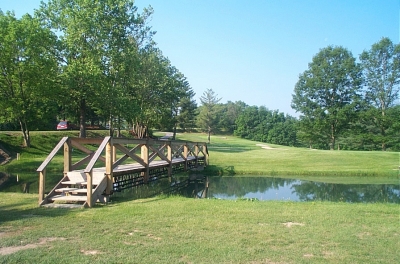 |
| Carts weren't made to cross this bridge, but then again, the Lower Cascades Course just begs you to walk it. |
Similarly, if there's a place that symbolizes a dynasty in golf, it's the Homestead, because its three courses were all designed by gentlemen who represent the best in golf in their respective genres of time. The Old Course boasts Donald Ross; The Cascades is the work of William S. Flynn; and The Lower Cascades carries the signature of Robert Trent Jones. It's hard to fathom collecting three courses by these legendary architects under one ownership and within ten minutes of each other, but The Homestead's done it. And the three layouts have definitely spanned the decades.
All three courses are exceptional, and present different enjoyments and difficulties. Here, we'll focus on the Robert Trent Jones designed Lower Cascades course. The course opened in 1963, forty years after The Homestead's second course, The Cascades. Not only does it contain some of the incredible mountain qualities of its predecessors, it offers something the others often don't -- some flat ground. The layout compliments the older courses without offering a warmed over recreation -- the true mark of quality.
The majority of the Lower Cascades' holes lie in a beautiful valley, with a few winding up onto the ridges. You'll get all the breathtaking views of the other two layouts without needing to pack ropes to get to the next hole.
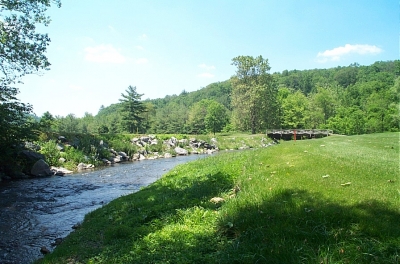 |
| Just like the other courses at The Homestead, natural elements are a large part of the experience at The Lower Cascades. |
The Lower Cascades is also much more open than the tree-lined Cascades and Old Course (though the Old Course is pretty forgiving from the lost ball standpoint), and the rough's shorter too. In other words, you'll be able to spray the ball around a little more without incurring the penalties. By now, you're probably thinking this is the 'cruiser' course of the three, good for a break after spending much of your time in the trees on the other layouts.
Wrong. While it's often the case that a course is tougher than it looks (like the Old Course), the concept certainly applies to the Lower Cascades. If you play it from the back tees, you'll need to be long and straight -- and hope to have good fairway lies for your approach shots, because the greens are this course's main defense. The other two courses have smaller greens with milder undulations. Jones lulls you into complacency on these links, then takes his revenge on the putting surfaces. He'll test your short game at the Lower Cascades in different ways than the other layouts.
Don Ryder, The Homestead's Director of Golf, says the Lower Cascades will often provide the most challenge to better players at the resort, if its greens are cut low: "It's a little deceiving, but good players often find the Lower Cascades is the toughest to score well on. If you're good enough to keep the ball in the fairway at the Cascades, you're rewarded with mildly breaking putts on the greens. At the Lower Cascades, even if you hit all the fairways, you'll still have to contend with the slope on the greens to finish out the hole."
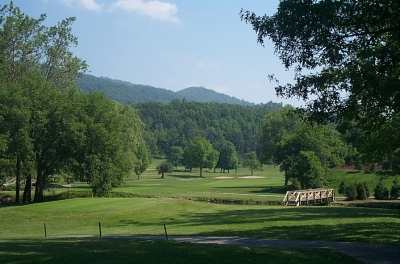 |
| An open, old-style course without houses. Golf like it used to be. |
"You'll find yourself trying so hard not to three-putt that you'll lag some putts that at other courses you might look to make -- so it's not an easy course to attack, despite its wide open qualities. Higher handicappers enjoy the acreage, and it helps them -- but the better players, who may not need as much room off the tee, find more challenge here in the short game."
"It's a very enjoyable resort course -- forgiving for the average player, and tough on those looking to shoot low."
That's an excellent synopsis of the Robert Trent Jones philosophy right there. Jones was one of the first to specifically incorporate separate teeing areas and position hazards where they're most threatening to good players. He also wanted casual players to enjoy the game -- so he sought to make a course playable enough for duffers, yet a thorough test for professionals and better players.
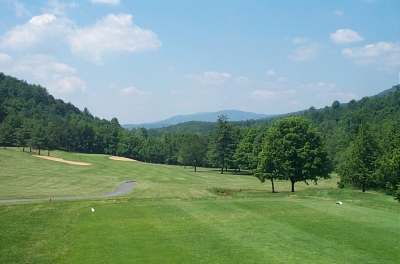 |
| The par four 13th hole is one of the most difficult on the course. |
It's redundant to say he succeeded at The Lower Cascades -- after all, Ryder competently spelled it out above. What's amazing is it's all so subtle -- the course's defenses. Jones rewards and punishes without a lot of flash or fanfare. And the ambiance is all in the setting and the game itself, not in golf course gimmickry or hazard profundity. Like its resort brethren, a timeless classic--the continuation of a remarkable legacy.
The day we played it, the greens rolled fast and difficult, but Ryder says they weren't nearly as quick as they'd be for a tournament. I feel sorry for those competitors already.
After a couple of mildly challenging opening holes, the Lower Cascades starts to roar. The third hole's a 450 yard, uphill dogleg right that requires a mighty drive from the back tees to even reach the short cut in the fairway. Trees guard against cutting too much off the leg on the right, and that's one way that Ryder says the course has changed over the years.
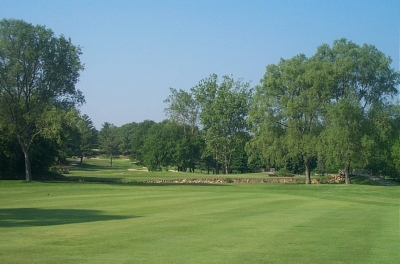 |
| You'll find some flat lies on the Lower Cascades, which is somewhat of a contrast to the Old Course and Cascades. |
"The Lower Cascades used to play quite a bit easier when the trees were smaller, because you could fly doglegs and shorten the distance. Now that they've grown, you'll need to be much more careful off the tee on quite a few holes -- because you can't just blow it over those trees anymore." It's just one way where nature takes back what technology giveth -- and makes the game of golf immortal.
Four's a nice par three -- 202 yards and slightly downhill. The green's amply guarded by four bunkers to each extreme, and is quite deep but not very wide. The shot plays well to a fade, as there's more room to run it on from the front left section.
Seven is a nice reachable par five, 493 yards from the back tees. To have any chance at the green in two, you'll need to avoid bunkers on either side of the fairway, conveniently located about a driver's distance from the tee box. If you go for it in two, carry a pond and negotiate bunkers front and long to reach the green -- but it's a big target. The safe route, as usual on a Jones course, makes par a very realistic possibility -- but he's daring you to try and do better.
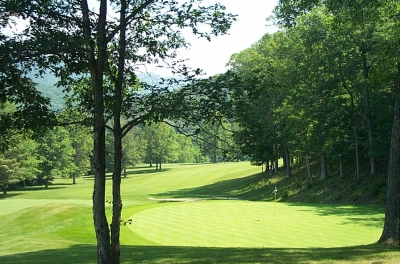 |
| The par four 10th hole requires a precisely placed drive and highly accurate second to have a chance at birdie on this hole. |
Nine is an excellent par four. Somewhat deceptive at 413 yards, it'll play much shorter because the second shot's downhill (dogleg left). You'll probably want to club down off the tee, unless you think you might be able to carry the trees to the left -- again, much easier in the old days.
Eleven presents the most spectacular tee shot on the course -- as you're teeing off a ridge back into the valley. It's a beautiful sight to see the ball's flight against the trees in the background -- must be incredible in the fall.
Fourteen is a very picturesque par three. Only 172 yards from the back, the green's well protected by the Cascades stream to the distant front and to the greenside right, as well as bunkers and deep rough. As with most holes, there is some room to run it up, so there are several shot options to play in order to avoid the trouble. But you'll have to fly it on to get close.
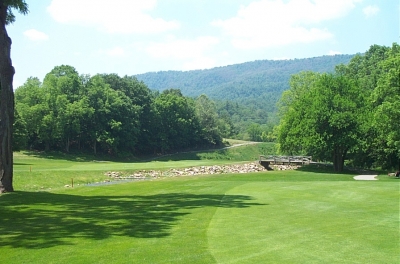 |
| Looking back from the 18th green, you'll appreciate the test that Robert Trent Jones dreamed up for you -- on this, and the previous 17 holes. |
Sixteen's another par four with options -- to lay up safely with an iron off the tee to the right side, or try and carry some trees to the left and cut off the dogleg. If you hit the trees, you may just find yourself in the creek. Worth the gamble?
Eighteen's a memorable closing hole. You'll probably club down off the tee, as the shot's downhill and a driver may put you through the fairway and give you a bad angle on your second. Second shots are to another back to front, undulating green with bunkers right and left, trees to the right and rough everywhere but the runup option. The Cascades stream meanders through the length of the entire hole, but doesn't really come into play if you give yourself enough margin for error.
Looking at the scorecard after the round, it might seem hard to believe you didn't shoot better than you did. The course appears so wide open and approachable, but plays much tougher than it looks. It's definitely a layout that's withstood the test of time, and will continue to do so. If you add it all up, the Lower Cascades is a solid legacy in the making.
Details:
The Lower Cascades at The Homestead
P.O. Box 2000
Hot Springs, VA 24445
Phone: (800) 838-1766
FAX: (540) 839-7954
Course Designer: Robert Trent Jones
Director of Golf: Don Ryder
Website: www.thehomestead.com/golf/lower.asp
|
Tees |
Yardage/Slope |
|
Blue |
6752/134 |
|
White |
6295/129 |
|
Red |
4710/110 |
Rates:
| Related Links | Comments on this article? | |
|
Maryland National Golf Club Hollow Creek Golf Club Rocky Gap Resort PB Dye Golf Club in Ijamsville Whiskey Creek Golf Club |
E-mail Jeff Rendall, Editor: jrendall@golftheunitedstates.com |











